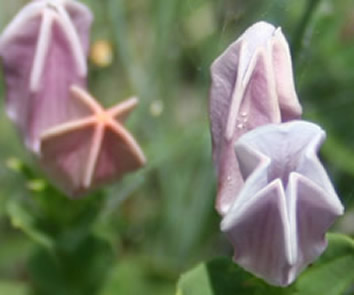Spigelia Gentianoides on:
[Wikipedia]
[Google]
[Amazon]
''Spigelia gentianoides'' is a rare species of flowering plant in the Loganiaceae known by the common names purpleflower pinkroot and gentian pinkroot. It is native to Alabama and Florida in the United States, where a few small populations remain. It is threatened by the loss and degradation of its habitat, and is a federally listed
The Nature Conservancy. Retrieved August 2, 2011. but plants can be seen in flower between April and October.USFWS
''Spigelia gentianoides'' Draft Recovery Plan.
February 2011. ''Spigelia gentianoides'' grows in wooded areas dominated by trees such as loblolly pine (''Pinus taeda''), longleaf pine (''Pinus palustris''), water oak (''Quercus nigra''),
''Spigelia gentianoides'' Five-year Review.
(PDF) January 2009. Retrieved August 2, 2011. There are two varieties of ''S. gentianoides''. The Alabama variety, var. ''alabamensis'', is limited to Bibb County. It grows at the Bibb County Glades, which has the highest level of biodiversity of any area in the state of Alabama. The var. ''gentianoides'' occurs in southern Alabama and the
There are two varieties of ''S. gentianoides''. The Alabama variety, var. ''alabamensis'', is limited to Bibb County. It grows at the Bibb County Glades, which has the highest level of biodiversity of any area in the state of Alabama. The var. ''gentianoides'' occurs in southern Alabama and the
endangered species
An endangered species is a species that is very likely to become extinct in the near future, either worldwide or in a particular political jurisdiction. Endangered species may be at risk due to factors such as habitat loss, poaching and inv ...
of the United States.
This perennial herb produces a slender, erect, red-tinged stem up to about 30 centimeters tall from a rhizome
In botany and dendrology, a rhizome (; , ) is a modified subterranean plant stem that sends out roots and shoots from its nodes. Rhizomes are also called creeping rootstalks or just rootstalks. Rhizomes develop from axillary buds and grow hori ...
. The oppositely arranged leaves are up to 5 centimeters long by 2 wide. The inflorescence is a raceme
A raceme ( or ) or racemoid is an unbranched, indeterminate type of inflorescence bearing flowers having short floral stalks along the shoots that bear the flowers. The oldest flowers grow close to the base and new flowers are produced as the s ...
of flowers atop the stem. Each flower has a tubular pink corolla up to 3 centimeters long with five triangular lobes. Blooming generally occurs in May through July,''Spigelia gentianoides''.The Nature Conservancy. Retrieved August 2, 2011. but plants can be seen in flower between April and October.USFWS
''Spigelia gentianoides'' Draft Recovery Plan.
February 2011. ''Spigelia gentianoides'' grows in wooded areas dominated by trees such as loblolly pine (''Pinus taeda''), longleaf pine (''Pinus palustris''), water oak (''Quercus nigra''),
laurel oak Laurel oak may refer to two species of trees native to the southeastern United States:
* '' Quercus hemisphaerica'', sometimes called sand laurel oak or Darlington oak
* '' Quercus laurifolia'', sometimes called swamp laurel oak, diamond-leaf oak, ...
(''Quercus hemisphaerica''), southern red oak (''Quercus falcata''), and black tupelo (''Nyssa sylvatica''). It also occurs in dolomite glades in Alabama.USFWS''Spigelia gentianoides'' Five-year Review.
(PDF) January 2009. Retrieved August 2, 2011.
 There are two varieties of ''S. gentianoides''. The Alabama variety, var. ''alabamensis'', is limited to Bibb County. It grows at the Bibb County Glades, which has the highest level of biodiversity of any area in the state of Alabama. The var. ''gentianoides'' occurs in southern Alabama and the
There are two varieties of ''S. gentianoides''. The Alabama variety, var. ''alabamensis'', is limited to Bibb County. It grows at the Bibb County Glades, which has the highest level of biodiversity of any area in the state of Alabama. The var. ''gentianoides'' occurs in southern Alabama and the Florida Panhandle
The Florida Panhandle (also West Florida and Northwest Florida) is the northwestern part of the U.S. state of Florida; it is a Salient (geography), salient roughly long and wide, lying between Alabama on the north and the west, Georgia (U. ...
. There are five populations remaining, the largest two occurring in Jackson County. The third largest is located in the Geneva State Forest
Geneva State Forest is an Alabama state forest in Geneva County, Alabama in the United States. The forest is and sits at an elevation of . It is Alabama's largest state forest. According to the Alabama Forestry Commission the primary objective ...
in Alabama. The two varieties differ mainly in the shape of the flower, with var. ''alabamensis'' flowers opening up and var. ''gentianoides'' flowers remaining more tubular at peak flower maturity.
Threats to this plant include logging
Logging is the process of cutting, processing, and moving trees to a location for transport. It may include skidding, on-site processing, and loading of trees or logs onto trucks or skeleton cars.
Logging is the beginning of a supply chain ...
, fire suppression, and overcollection. Silviculture is a threat, as land is cleared for pine plantations. At the Alabama glades the plant is threatened by quarrying.
Controlled burn
A controlled or prescribed burn, also known as hazard reduction burning, backfire, swailing, or a burn-off, is a fire set intentionally for purposes of forest management, farming, prairie restoration or greenhouse gas abatement. A control ...
s have been found to increase the abundance of the plant, but if fires are too frequent the plant can be harmed.
References
{{Taxonbar, from=Q7577148 Loganiaceae Flora of Alabama Flora of Florida Taxa named by Alvan Wentworth Chapman Taxa named by Alphonse Pyramus de Candolle